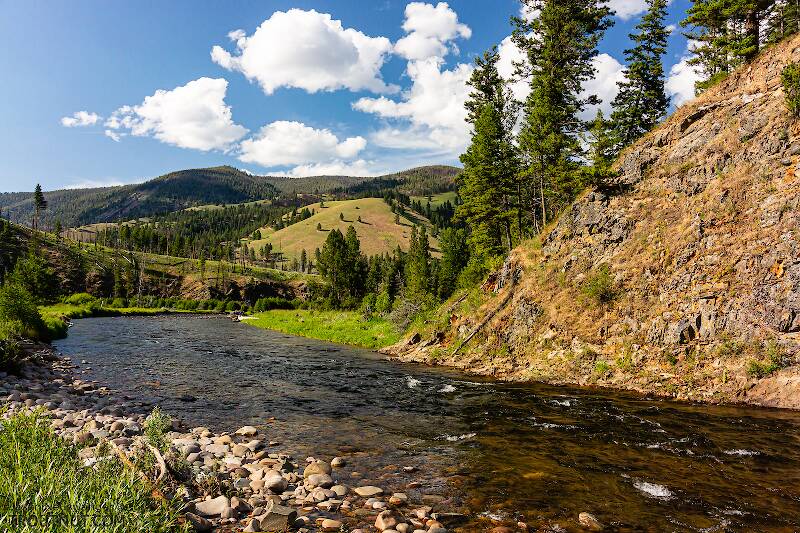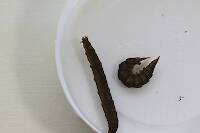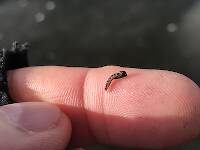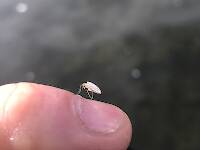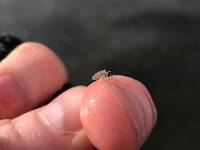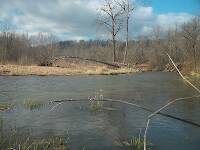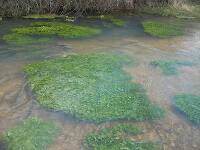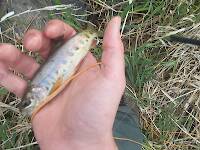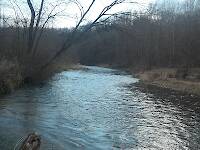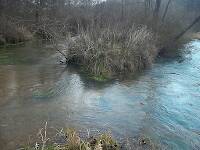
Salmonflies
Pteronarcys californica
The giant Salmonflies of the Western mountains are legendary for their proclivity to elicit consistent dry-fly action and ferocious strikes.
Featured on the forum

This specimen keys pretty easily to Onocosmoecus, and it closely resembles a specimen from Alaska which caddis expert Dave Ruiter recognized as this genus. As with that specimen, the only species in the genus documented in this area is Onocosmoecus unicolor, but Dave suggested for that specimen that there might be multiple not-yet-distinguished species under the unicolor umbrella and it would be best to stick with the genus-level ID. I'm doing the same for this one.

Troutnut is a project started in 2003 by salmonid ecologist Jason "Troutnut" Neuswanger to help anglers and
fly tyers unabashedly embrace the entomological side of the sport. Learn more about Troutnut or
support the project for an enhanced experience here.
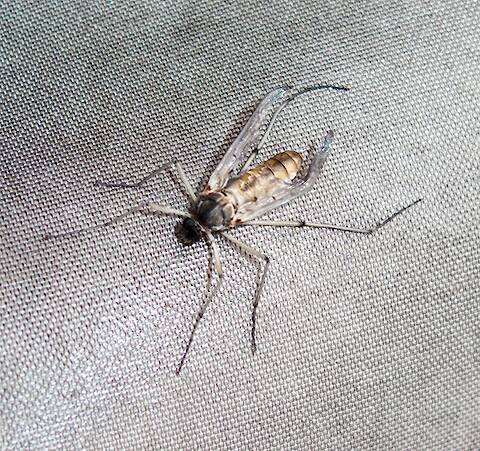
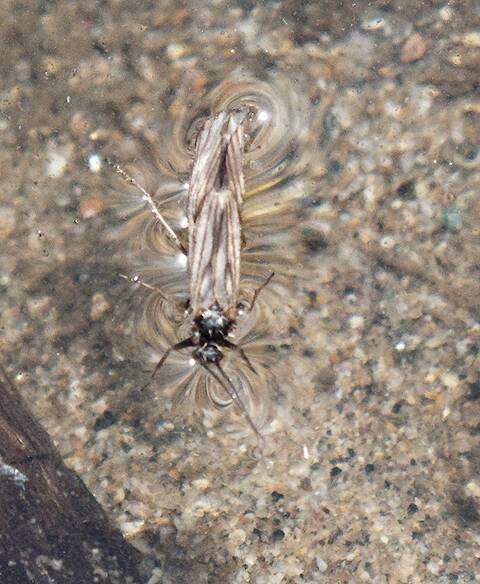
Bobbyg on May 16, 2010May 16th, 2010, 7:45 am EDT
Hello all,
My first post on your Forum.
Thanks for having me!
Trying to id this fly for a fellow angler.
Good sized rainbows were devouring them on the Arkansas in Colorado on Mother's Day weekend. I would just show the pics to my fly tying friends and have them whip something up that imitates this big ole midge. This fellow makes me curious also!wants to correctly id the fly.....
The general consensus is that it's a cranefly.
Very unusual for that time of year. The craneflys are typically active on the Arkansas in July and August. Size was in the 14 to 16 range.
The first pic is against a waders background. The hind legs and wings were, for lack of a better word, bent in getting the pic.
Thanks for any thoughts. Now, let's see if I can add oictures to this post????
My first post on your Forum.
Thanks for having me!
Trying to id this fly for a fellow angler.
Good sized rainbows were devouring them on the Arkansas in Colorado on Mother's Day weekend. I would just show the pics to my fly tying friends and have them whip something up that imitates this big ole midge. This fellow makes me curious also!wants to correctly id the fly.....
The general consensus is that it's a cranefly.
Very unusual for that time of year. The craneflys are typically active on the Arkansas in July and August. Size was in the 14 to 16 range.
The first pic is against a waders background. The hind legs and wings were, for lack of a better word, bent in getting the pic.
Thanks for any thoughts. Now, let's see if I can add oictures to this post????
"Many men go fishing all of their lives without knowing it is not fish they are after."
- Henry David Thoreau
- Henry David Thoreau
CaseyP on May 16, 2010May 16th, 2010, 2:23 pm EDT
welcome, BobbyG!
if you go over to the Photography section of this forum, there are instructions there about putting up photos.
the bug-wallahs have been quieter than usual lately. maybe a busy time in academe. eventually one will wander by!
if you go over to the Photography section of this forum, there are instructions there about putting up photos.
the bug-wallahs have been quieter than usual lately. maybe a busy time in academe. eventually one will wander by!
"You can observe a lot by watching." Yogi Berra
Jmd123 on May 16, 2010May 16th, 2010, 7:58 pm EDT
OK, folks, I'm a "bugologist" - MS in entomology, Michigan State University, 1991, took the class from Richard Merritt of Merritt and Cummins. If that means anything to any of you out there...
First thing I need to know is, how big is this here creature? If it's a little guy (a few millimeters), probably a midge, family Chironomidae. If it's a bigger dude, say 10-20 mm, I would say yes, it's a cranefly, family Tipulidae. As far as genus and species, you'd need to send me a specimen in alcohol for me to look at under a microscope. If you want to imitate it, just sudy the pictures closely and I'm sure you'll come up with SOMETHING. I have the utmost confidence in all you troutnuts out there, of both genders (wink, CaseyP ;oD).
BTW, if you want to take a Chironomid larva to genus, you have to SMASH THEIR HEADS on a microscope slide, just so the head structures all spread out nice and visible (NOT easy - you usually have to go hunting around the slide for the parts YOU NEED), magnify them anywhere from 100x to 1250x, and that's where all of the diagnostic features lie. I have done around 1000 of these things - 700-800 for a never-completed PhD and about 250 for a subsequent environmental consulting project - and though the work is VERY tedious they are really interesting little creatures with lots of variation in morphology, lifestyles, environmental preferences/tolerances, etc. Not only that, but there have been studies of trout streams that have EXCLUDED these insects out of sheer INTIMIDATION (Oh GOD, I don't want to deal with those TINY THINGS!!!), and their conclusions were, get this, "there's not enough benthic macroinvertebrates in this stream to support this trout population." ?????????????????? Guess what happened when they ADDED the Chironomidae back in? "Oh, there's PLENTY of food in this stream!!"
Well, DUUUUUUUUUUUUUUUUHHHHHH!!!!!!!!!!!!
You freaking WEENIES!!!!!!
I guess the moral of that story is, never send a fisheries biologist to do an entomologist's job.
But, I digress...
Jonathon ;oD
First thing I need to know is, how big is this here creature? If it's a little guy (a few millimeters), probably a midge, family Chironomidae. If it's a bigger dude, say 10-20 mm, I would say yes, it's a cranefly, family Tipulidae. As far as genus and species, you'd need to send me a specimen in alcohol for me to look at under a microscope. If you want to imitate it, just sudy the pictures closely and I'm sure you'll come up with SOMETHING. I have the utmost confidence in all you troutnuts out there, of both genders (wink, CaseyP ;oD).
BTW, if you want to take a Chironomid larva to genus, you have to SMASH THEIR HEADS on a microscope slide, just so the head structures all spread out nice and visible (NOT easy - you usually have to go hunting around the slide for the parts YOU NEED), magnify them anywhere from 100x to 1250x, and that's where all of the diagnostic features lie. I have done around 1000 of these things - 700-800 for a never-completed PhD and about 250 for a subsequent environmental consulting project - and though the work is VERY tedious they are really interesting little creatures with lots of variation in morphology, lifestyles, environmental preferences/tolerances, etc. Not only that, but there have been studies of trout streams that have EXCLUDED these insects out of sheer INTIMIDATION (Oh GOD, I don't want to deal with those TINY THINGS!!!), and their conclusions were, get this, "there's not enough benthic macroinvertebrates in this stream to support this trout population." ?????????????????? Guess what happened when they ADDED the Chironomidae back in? "Oh, there's PLENTY of food in this stream!!"
Well, DUUUUUUUUUUUUUUUUHHHHHH!!!!!!!!!!!!
You freaking WEENIES!!!!!!
I guess the moral of that story is, never send a fisheries biologist to do an entomologist's job.
But, I digress...
Jonathon ;oD
No matter how big the one you just caught is, there's always a bigger one out there somewhere...
Jmd123 on May 16, 2010May 16th, 2010
P.S. I just reread the post. Size #14-16 is most DEFINITELY a midge.
JMD
JMD
No matter how big the one you just caught is, there's always a bigger one out there somewhere...
Bobbyg on May 17, 2010May 17th, 2010, 2:28 am EDT
Thanks for the info.
I'm of the opinion, not being an entomologist, that the fly is indeed a good sized midge, most probably the cranefly (tipulidae).
Can't explain the early season hatch but I've been advised by others in different parts of the country that the craneflys have appeared early this season.
I'll advise this fellow to carry some of his favorite cranefly patterns just in case he runs into this phenomenon again.
Again, thanks!
p.s. Casey, can you see the pics ok?
I'm of the opinion, not being an entomologist, that the fly is indeed a good sized midge, most probably the cranefly (tipulidae).
Can't explain the early season hatch but I've been advised by others in different parts of the country that the craneflys have appeared early this season.
I'll advise this fellow to carry some of his favorite cranefly patterns just in case he runs into this phenomenon again.
Again, thanks!
p.s. Casey, can you see the pics ok?
"Many men go fishing all of their lives without knowing it is not fish they are after."
- Henry David Thoreau
- Henry David Thoreau
Oldredbarn on May 17, 2010May 17th, 2010, 5:37 am EDT
"At least 4256 species of crane flies have been described."
I have had them on the screen at home here in Michigan throughout April...It was rather warm here for that time of year. I can hardly remember a time when I've been fishing where I didn't have crane fly larvae somewhere on my waders or wading boots...I think they are like mosquitoes and can hatch just about anytime...Just be thankful that they don't bite...Though there may be some that do considering there are zillions of them...I am the biting bug attractor of all time and I've never been bit anyway...My fishing pals love fishing with me because they claim never to get bit while fishing with me...I on-the-other-hand usually have a massive swarm orbitting my head! I also tend to get laid more than they do, but I've been unable to prove a correlation...
Spence
I have had them on the screen at home here in Michigan throughout April...It was rather warm here for that time of year. I can hardly remember a time when I've been fishing where I didn't have crane fly larvae somewhere on my waders or wading boots...I think they are like mosquitoes and can hatch just about anytime...Just be thankful that they don't bite...Though there may be some that do considering there are zillions of them...I am the biting bug attractor of all time and I've never been bit anyway...My fishing pals love fishing with me because they claim never to get bit while fishing with me...I on-the-other-hand usually have a massive swarm orbitting my head! I also tend to get laid more than they do, but I've been unable to prove a correlation...
Spence
"Even when my best efforts fail it's a satisfying challenge, and that, after all, is the essence of fly fishing." -Chauncy Lively
"Envy not the man who lives beside the river, but the man the river flows through." Joseph T Heywood
"Envy not the man who lives beside the river, but the man the river flows through." Joseph T Heywood
Jmd123 on May 17, 2010May 17th, 2010, 5:46 am EDT
Again, guys, that looks more like a Chironomid midge to me - almost all craneflies (Tipulidae) are considerably larger. Remember, you are dealing with a genuine bugologist here. And, truth be known, Chironomids can get as large as size 8!! I've seen plenty in the #10-12 range myself, plus some good-sized larvae.
Spence, crane flies cannot bite you - they have no functional mouthparts as adults. They do all of their feeding as larvae, like mayflies, and the adult stage is just for winged dispersal to new habitat. This should be much relief to those who think they really are giant mosquitos!
Jonathon
Spence, crane flies cannot bite you - they have no functional mouthparts as adults. They do all of their feeding as larvae, like mayflies, and the adult stage is just for winged dispersal to new habitat. This should be much relief to those who think they really are giant mosquitos!
Jonathon
No matter how big the one you just caught is, there's always a bigger one out there somewhere...
Oldredbarn on May 17, 2010May 17th, 2010, 6:27 am EDT
"Spence, crane flies cannot bite you - they have no functional mouthparts as adults."
That's what she said!
Spence
That's what she said!
Spence
"Even when my best efforts fail it's a satisfying challenge, and that, after all, is the essence of fly fishing." -Chauncy Lively
"Envy not the man who lives beside the river, but the man the river flows through." Joseph T Heywood
"Envy not the man who lives beside the river, but the man the river flows through." Joseph T Heywood
Bobbyg on May 17, 2010May 17th, 2010, 10:56 am EDT
Don't chironomids have those fussy looking pincer-looking things coming out of their heads?
Sounds like the title for a helluva thesis or a plot line for the latest alien invasion movie!!!
Sounds like the title for a helluva thesis or a plot line for the latest alien invasion movie!!!
"Many men go fishing all of their lives without knowing it is not fish they are after."
- Henry David Thoreau
- Henry David Thoreau
JOHNW on May 17, 2010May 17th, 2010, 11:17 am EDT
Jonathon,
Not sure but around these parts a size 14-16 would be perfect for a cranefly. That however looks nothing like what i know as a cranefly. To me craneflies look much more like what we call blind mosquitos with long gangly legs and split delta style wings. (Obviously not an ento, ente, enta screw it "bug-walla" here)
I'd go with the midge. Of course in some parts any bug smaller than an 18 is a midge soooooooooooooooooo..
JW
Not sure but around these parts a size 14-16 would be perfect for a cranefly. That however looks nothing like what i know as a cranefly. To me craneflies look much more like what we call blind mosquitos with long gangly legs and split delta style wings. (Obviously not an ento, ente, enta screw it "bug-walla" here)
I'd go with the midge. Of course in some parts any bug smaller than an 18 is a midge soooooooooooooooooo..
JW
"old habits are hard to kill once you have gray in your beard" -Old Red Barn
Jmd123 on May 17, 2010May 17th, 2010, 12:42 pm EDT
JOHNW, I don't think it looks like a cranefly either - I've never seen one with wings folded tent-style over the back. They are always held out at a 45-degree angle from the body, whereas the Chironomids I have seen either fold them tent-style over the back or hold them flat more or less parallel to the body. Those legs don't look gangly enough for a cranefly either.
Bobbyg, those "pincer-like" things you are talking about are antennae, and only the males have what we call "plumose" or feathery antennae, which are for picking up phermones emitted by females of the species (true also in many moths). The species that has some of the most prominent antennae is Chironomus plumosus, on which I used to catch big fat bluegill in Missouri. They get pretty big, up to about a size 10.
Also, be aware there are other families besides Chironomidae and Tipulidae that look similar. I think for our purposes we can merely come up with an appropriate imitation without worrying about the actual family ID. Like I said, if you've REALLY gotta know, send me some specimens in alcohol and I'll get ahold of a copy of Merritt & Cummins 3rd ed. and a good dissecting microscope and I can tell ya, probably down to genus. It would actualy be good to keep me in practice, as I'm doing with my botany on all the wildflower walks I go on until I FINALLY get a job again...("Somewhere, over the rainbow [trout]...")
Jonathon
Bobbyg, those "pincer-like" things you are talking about are antennae, and only the males have what we call "plumose" or feathery antennae, which are for picking up phermones emitted by females of the species (true also in many moths). The species that has some of the most prominent antennae is Chironomus plumosus, on which I used to catch big fat bluegill in Missouri. They get pretty big, up to about a size 10.
Also, be aware there are other families besides Chironomidae and Tipulidae that look similar. I think for our purposes we can merely come up with an appropriate imitation without worrying about the actual family ID. Like I said, if you've REALLY gotta know, send me some specimens in alcohol and I'll get ahold of a copy of Merritt & Cummins 3rd ed. and a good dissecting microscope and I can tell ya, probably down to genus. It would actualy be good to keep me in practice, as I'm doing with my botany on all the wildflower walks I go on until I FINALLY get a job again...("Somewhere, over the rainbow [trout]...")
Jonathon
No matter how big the one you just caught is, there's always a bigger one out there somewhere...
CaseyP on May 17, 2010May 17th, 2010, 3:09 pm EDT
oh, yes! the pics are just fine.
"You can observe a lot by watching." Yogi Berra
Quick Reply
Related Discussions
Topic
Replies
Last Reply
Re: Unidentified: Not a Trichoptera or Ephemeroptera
In the Insect Order Ephemeroptera by CheddarDan
In the Insect Order Ephemeroptera by CheddarDan
1
Apr 6, 2010
by GONZO
by GONZO

